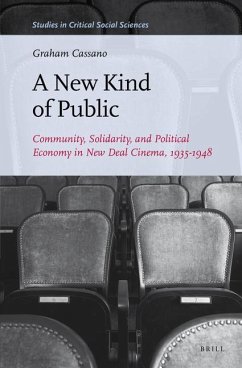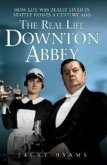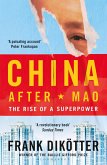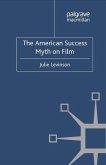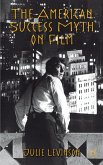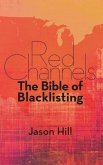Graham Cassano
A New Kind of Public
Community, Solidarity, and Political Economy in New Deal Cinema, 1935-1948
Graham Cassano
A New Kind of Public
Community, Solidarity, and Political Economy in New Deal Cinema, 1935-1948
- Gebundenes Buch
- Merkliste
- Auf die Merkliste
- Bewerten Bewerten
- Teilen
- Produkt teilen
- Produkterinnerung
- Produkterinnerung
In A New Kind of Public: Community, Solidarity, and Political Economy in New Deal Cinema, 1935-1948, Graham Cassano examines the contending ways in which New Deal cinema attempted to explain the causes and consequences of the Great Depression to audiences shaped by economic struggle and new forms of collective solidarity.
Andere Kunden interessierten sich auch für
![The Real Life Downton Abbey: How Life Was Really Lived in Stately Homes a Century Ago The Real Life Downton Abbey: How Life Was Really Lived in Stately Homes a Century Ago]() Jacky HyamsThe Real Life Downton Abbey: How Life Was Really Lived in Stately Homes a Century Ago15,99 €
Jacky HyamsThe Real Life Downton Abbey: How Life Was Really Lived in Stately Homes a Century Ago15,99 €![China After Mao China After Mao]() Frank DikötterChina After Mao17,00 €
Frank DikötterChina After Mao17,00 €![The American Success Myth on Film The American Success Myth on Film]() J. LevinsonThe American Success Myth on Film37,99 €
J. LevinsonThe American Success Myth on Film37,99 €![The American Success Myth on Film The American Success Myth on Film]() J. LevinsonThe American Success Myth on Film37,99 €
J. LevinsonThe American Success Myth on Film37,99 €![The American Success Myth on Film The American Success Myth on Film]() J. LevinsonThe American Success Myth on Film28,99 €
J. LevinsonThe American Success Myth on Film28,99 €![Performance Affects Performance Affects]() J. ThompsonPerformance Affects37,99 €
J. ThompsonPerformance Affects37,99 €![Red Channels: The Bible of Blacklisting (hardback) Red Channels: The Bible of Blacklisting (hardback)]() Jason HillRed Channels: The Bible of Blacklisting (hardback)39,99 €
Jason HillRed Channels: The Bible of Blacklisting (hardback)39,99 €-
-
-
In A New Kind of Public: Community, Solidarity, and Political Economy in New Deal Cinema, 1935-1948, Graham Cassano examines the contending ways in which New Deal cinema attempted to explain the causes and consequences of the Great Depression to audiences shaped by economic struggle and new forms of collective solidarity.
Hinweis: Dieser Artikel kann nur an eine deutsche Lieferadresse ausgeliefert werden.
Hinweis: Dieser Artikel kann nur an eine deutsche Lieferadresse ausgeliefert werden.
Produktdetails
- Produktdetails
- Verlag: Brill
- Seitenzahl: 228
- Erscheinungstermin: 18. Juli 2014
- Englisch
- Abmessung: 239mm x 160mm x 18mm
- Gewicht: 476g
- ISBN-13: 9789004275195
- ISBN-10: 9004275193
- Artikelnr.: 40907553
- Herstellerkennzeichnung
- Libri GmbH
- Europaallee 1
- 36244 Bad Hersfeld
- 06621 890
- Verlag: Brill
- Seitenzahl: 228
- Erscheinungstermin: 18. Juli 2014
- Englisch
- Abmessung: 239mm x 160mm x 18mm
- Gewicht: 476g
- ISBN-13: 9789004275195
- ISBN-10: 9004275193
- Artikelnr.: 40907553
- Herstellerkennzeichnung
- Libri GmbH
- Europaallee 1
- 36244 Bad Hersfeld
- 06621 890
Graham Cassano is Associate Professor of Sociology at Oakland University, in Rochester, Michigan. He has published articles on a range of topics, including Thorstein Veblen's social theories, the sociology of American labor, and postmodern Marxian theory. He edited the volume, Class Struggle on the Homefront (Palgrave, 2010) and co-edited the volume, with Richard A. Dello Buono, Crisis, Politics, and Critical Sociology (Brill, 2009).
Acknowledgements
Introduction: A Sociological Approach to New Deal Cinema
The Problem
Symbols, Experience, and Overdetermination
Interpellative Intention
Context
The Force of Imagined Things
"a new kind of public"
Working Class Community
The Hollywood Cultural Apparatus
Plan of the Work
1. 1935-1936 Black Fury and RiffRaff
Radical Paternalism and Labor's Solidarity
Black Fury and the Construction of Whiteness
Black Fury's Paternalism
RiffRaff
Women's Exploitation in the Household
Women's Exploitation in the Cannery
Anti-Marx
Race, Wealth, and Desire
Responsible Unionism
Cinematic Contradictions
2. 1936 My Man Godfrey
Cinematic Corporatism
Forgotten Men
Two Communities
Responsibility and Recognition
Mastery and Servitude
"The only butler we ever had who understood women"
Captain of Finance
Mask as Mark
3. 1936 Swing Time
Recognition and "Schemes of Life"
The Power of Fashion
The Political Economy of Desire
Swing Time's Realism
Immigrants and The Shadows of Blackness
Culture and Barbarism
4. 1937 The Hurricane
Popular Front and Labor Affiliations
Colonial Order and Pacific Passions
"I'm just the same as a white man"
Two Communities
"Look at them Dance. There's the island's answer to your law"
De-Colonized Independence and Enslaved Servility
"You're all guilty"
Contradictions and Paradoxes
5. Ginger Rogers and the (Hollywood) Proletarian Imaginary, 1939-1941
5TH Avenue Girl (1939)
Bachelor Mother (1939)
Kitty Foyle (1940)
Tom, Dick, and Harry (1941)
6. John Ford, From Radical Critique to the White Garrison State, 1940-1948
Radical Traditionalism in The Grapes of Wrath
Symbolic Domination as Traditional Compensation
The Language of Patriarchy
Allegories of Race
Narrating Trauma as Radical Critique
Capital, Class and the Charmed Circle of the State
Workers' Control
The Paradoxes of Radical Representation
Two Voices
From Class Conflict (Back) to Corporate Community
"all I can see is the flags"
"We'll have no more Grapes of Wrath..."
Epilogue: Psycho (1960) and the New Domestic Gaze
The Gaze
Interpellating Community
The Loss of the Collective Spectacle
References
Films Cited
Index
Introduction: A Sociological Approach to New Deal Cinema
The Problem
Symbols, Experience, and Overdetermination
Interpellative Intention
Context
The Force of Imagined Things
"a new kind of public"
Working Class Community
The Hollywood Cultural Apparatus
Plan of the Work
1. 1935-1936 Black Fury and RiffRaff
Radical Paternalism and Labor's Solidarity
Black Fury and the Construction of Whiteness
Black Fury's Paternalism
RiffRaff
Women's Exploitation in the Household
Women's Exploitation in the Cannery
Anti-Marx
Race, Wealth, and Desire
Responsible Unionism
Cinematic Contradictions
2. 1936 My Man Godfrey
Cinematic Corporatism
Forgotten Men
Two Communities
Responsibility and Recognition
Mastery and Servitude
"The only butler we ever had who understood women"
Captain of Finance
Mask as Mark
3. 1936 Swing Time
Recognition and "Schemes of Life"
The Power of Fashion
The Political Economy of Desire
Swing Time's Realism
Immigrants and The Shadows of Blackness
Culture and Barbarism
4. 1937 The Hurricane
Popular Front and Labor Affiliations
Colonial Order and Pacific Passions
"I'm just the same as a white man"
Two Communities
"Look at them Dance. There's the island's answer to your law"
De-Colonized Independence and Enslaved Servility
"You're all guilty"
Contradictions and Paradoxes
5. Ginger Rogers and the (Hollywood) Proletarian Imaginary, 1939-1941
5TH Avenue Girl (1939)
Bachelor Mother (1939)
Kitty Foyle (1940)
Tom, Dick, and Harry (1941)
6. John Ford, From Radical Critique to the White Garrison State, 1940-1948
Radical Traditionalism in The Grapes of Wrath
Symbolic Domination as Traditional Compensation
The Language of Patriarchy
Allegories of Race
Narrating Trauma as Radical Critique
Capital, Class and the Charmed Circle of the State
Workers' Control
The Paradoxes of Radical Representation
Two Voices
From Class Conflict (Back) to Corporate Community
"all I can see is the flags"
"We'll have no more Grapes of Wrath..."
Epilogue: Psycho (1960) and the New Domestic Gaze
The Gaze
Interpellating Community
The Loss of the Collective Spectacle
References
Films Cited
Index
Acknowledgements
Introduction: A Sociological Approach to New Deal Cinema
The Problem
Symbols, Experience, and Overdetermination
Interpellative Intention
Context
The Force of Imagined Things
"a new kind of public"
Working Class Community
The Hollywood Cultural Apparatus
Plan of the Work
1. 1935-1936 Black Fury and RiffRaff
Radical Paternalism and Labor's Solidarity
Black Fury and the Construction of Whiteness
Black Fury's Paternalism
RiffRaff
Women's Exploitation in the Household
Women's Exploitation in the Cannery
Anti-Marx
Race, Wealth, and Desire
Responsible Unionism
Cinematic Contradictions
2. 1936 My Man Godfrey
Cinematic Corporatism
Forgotten Men
Two Communities
Responsibility and Recognition
Mastery and Servitude
"The only butler we ever had who understood women"
Captain of Finance
Mask as Mark
3. 1936 Swing Time
Recognition and "Schemes of Life"
The Power of Fashion
The Political Economy of Desire
Swing Time's Realism
Immigrants and The Shadows of Blackness
Culture and Barbarism
4. 1937 The Hurricane
Popular Front and Labor Affiliations
Colonial Order and Pacific Passions
"I'm just the same as a white man"
Two Communities
"Look at them Dance. There's the island's answer to your law"
De-Colonized Independence and Enslaved Servility
"You're all guilty"
Contradictions and Paradoxes
5. Ginger Rogers and the (Hollywood) Proletarian Imaginary, 1939-1941
5TH Avenue Girl (1939)
Bachelor Mother (1939)
Kitty Foyle (1940)
Tom, Dick, and Harry (1941)
6. John Ford, From Radical Critique to the White Garrison State, 1940-1948
Radical Traditionalism in The Grapes of Wrath
Symbolic Domination as Traditional Compensation
The Language of Patriarchy
Allegories of Race
Narrating Trauma as Radical Critique
Capital, Class and the Charmed Circle of the State
Workers' Control
The Paradoxes of Radical Representation
Two Voices
From Class Conflict (Back) to Corporate Community
"all I can see is the flags"
"We'll have no more Grapes of Wrath..."
Epilogue: Psycho (1960) and the New Domestic Gaze
The Gaze
Interpellating Community
The Loss of the Collective Spectacle
References
Films Cited
Index
Introduction: A Sociological Approach to New Deal Cinema
The Problem
Symbols, Experience, and Overdetermination
Interpellative Intention
Context
The Force of Imagined Things
"a new kind of public"
Working Class Community
The Hollywood Cultural Apparatus
Plan of the Work
1. 1935-1936 Black Fury and RiffRaff
Radical Paternalism and Labor's Solidarity
Black Fury and the Construction of Whiteness
Black Fury's Paternalism
RiffRaff
Women's Exploitation in the Household
Women's Exploitation in the Cannery
Anti-Marx
Race, Wealth, and Desire
Responsible Unionism
Cinematic Contradictions
2. 1936 My Man Godfrey
Cinematic Corporatism
Forgotten Men
Two Communities
Responsibility and Recognition
Mastery and Servitude
"The only butler we ever had who understood women"
Captain of Finance
Mask as Mark
3. 1936 Swing Time
Recognition and "Schemes of Life"
The Power of Fashion
The Political Economy of Desire
Swing Time's Realism
Immigrants and The Shadows of Blackness
Culture and Barbarism
4. 1937 The Hurricane
Popular Front and Labor Affiliations
Colonial Order and Pacific Passions
"I'm just the same as a white man"
Two Communities
"Look at them Dance. There's the island's answer to your law"
De-Colonized Independence and Enslaved Servility
"You're all guilty"
Contradictions and Paradoxes
5. Ginger Rogers and the (Hollywood) Proletarian Imaginary, 1939-1941
5TH Avenue Girl (1939)
Bachelor Mother (1939)
Kitty Foyle (1940)
Tom, Dick, and Harry (1941)
6. John Ford, From Radical Critique to the White Garrison State, 1940-1948
Radical Traditionalism in The Grapes of Wrath
Symbolic Domination as Traditional Compensation
The Language of Patriarchy
Allegories of Race
Narrating Trauma as Radical Critique
Capital, Class and the Charmed Circle of the State
Workers' Control
The Paradoxes of Radical Representation
Two Voices
From Class Conflict (Back) to Corporate Community
"all I can see is the flags"
"We'll have no more Grapes of Wrath..."
Epilogue: Psycho (1960) and the New Domestic Gaze
The Gaze
Interpellating Community
The Loss of the Collective Spectacle
References
Films Cited
Index

